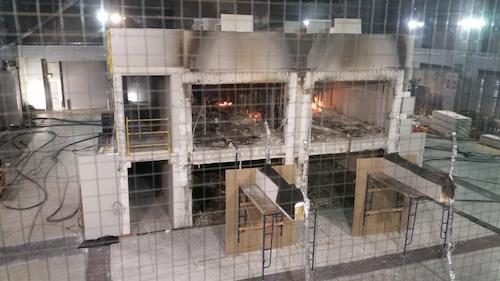WEDNESDAY, MAY 23, 2018
The Wood Products Council, along with the USDA Forest Service Forest Products Lab, and Softwood Lumber Board, recently completed a second series of blast tests on cross-laminated timber structures at the Tyndall Air Force Base in Panama City, Florida.
The Tests
The tests aimed to look at the effectiveness of design assumptions and methodology in predicting elastic response of CLT to dynamic loads and were meant to simulate conditions associated with a five-story residential or office building.
These same structures were used in a series of blast tests in 2016, and WoodWorks says that all structures remained intact under significant explosive loading.
"Last year, we tested the structures under their own self-weight," said Bill Parsons, VP of Operations for WoodWorks. "Those tests were successful and, this year, we built on that effort by testing whether the design methods established as a result of those initial tests needed to be adjusted when the buildings carried typical gravity loads and included different connection configurations, increased panel thickness, and alternate mass timber wall systems."
Four tests were performed. Tests 1 and 2 had the same blast load size and configurations as the prior testing. Tests 3 and 4 altered some variables, however. One building used five-ply CLT front-wall panels, the second used off-the-shelf prefabricated angle brackets and the third included nail-laminated timber (NLT) front panels. Reflected pressure, peak deflections and panel acceleration were recorded at front and side faces in order to compare results to previous testing.
WoodWorks noted that all three structures remained standing, even after the fourth and largest blast, which the organization says was intended to take the buildings "well beyond their design intent."
While panel rupture was expected—and observed—the buildings remained safe enough to enter after blasting.
To analyze the results, WoodWorks worked with Karagozian & Case Inc., the Air Force Civil Engineer Center and the U.S. Army Corps of Engineers.
CLT
The WoodWorks tests aren't the only studies being carried out on CLT systems—a building technique that's growing in popularity across the globe.

 |
| American Wood Council |
|
The WoodWorks tests aren't the only studies being carried out on CLT systems—a building technique that's growing in popularity across the globe. |
Last August, the International Code Council Ad-hoc Committee on Tall Wood Buildings, in cooperation with the U.S. Forest Service's Forest Products Laboratory, completed five full-scale mass timber fire tests at the Bureau of Alcohol, Tobacco, Firearms, and Explosives’ Fire Research Laboratory, in Beltsville, Maryland.
Those scenarios included:
Stephen J. DiGiovanni, P.E., Ad-hoc Committee Chair, said at the time that the tests would inform future code recommendations, and that tests in general are an important part of the research that need to go into validating the performance of tall wood buildings.
Tagged categories: Good Technical Practice; Laboratory testing; Testing + Evaluation; Wood